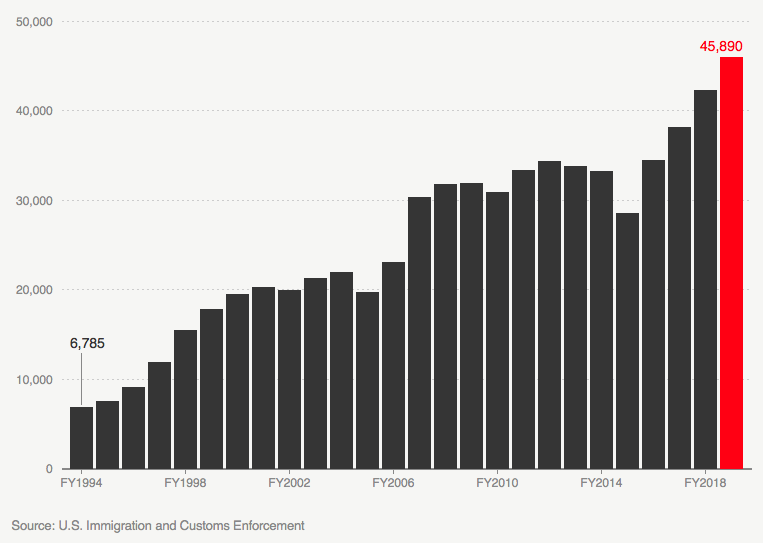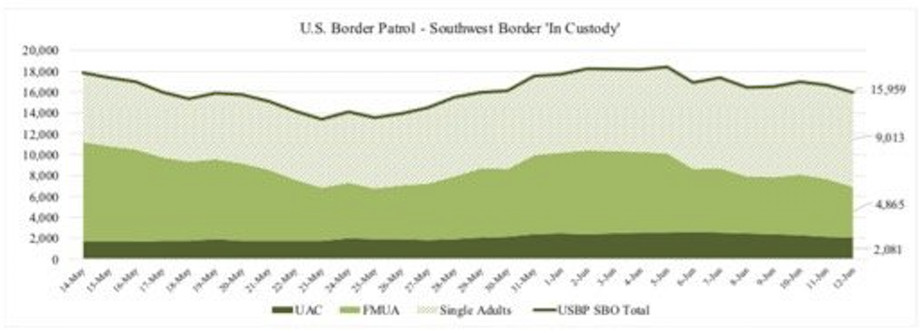Over 100,000 immigrants are in detention right now
Read more about InAlienable.Support Quixote Center’s InAlienable program!
InAlienableDaily Dispatch
June 28, 2019
Immigration and Customs Enforcement (53,000 detained)
If you read almost any story on immigration that references the number of people being detained, what you see is that we have passed 53,000 people currently detained by Immigration and Customs Enforcement (ICE) in recent weeks. This is a 40 percent increase above the 38,000 daily average at the end of the Obama administration - which was, at the time, the highest daily average on record. From October 2017 to September 2018, there were 396,448 people booked into ICE detention facilities - a number that will increase significantly during the current fiscal year. Of these detainees, 242,778 people were transferred to ICE from Customs and Border Protection. The remaining detainees were arrested during internal ICE enforcement actions - which happen all over the country.
Changes in daily average of detentions 1994-2018

As alarming as these numbers are, this is only part of the story of immigrant detention. In reality there are 100,000 immigrants currently being detained on any given day in different parts of the federal enforcement system. Media reporting on detention and federal enforcement should account for this.
Customs and Border Protection (16,000 detained)
The Border Patrol apprehends - and then detains for some period of time - hundreds of thousands of people each year. From October 2018 to May 31, 2019 the number of apprehensions was 598,714, a near 50 percent increase over the total from last fiscal year (404,142 arrests from October 2017 to September 2018). Almost all of these apprehensions (593,507) were along the U.S./Mexico border.
Once people are arrested they are detained while a determination is made about what happens next to them. Many adults and families will be transferred to ICE Custody. Children will wait transfer to Health and Human Services’ Office of Refugee Resettlement (ORR). In some cases, people may be released with an immigration court date, or they may be referred for prosecution for illegal entry, and end up in a federal prison. If from Mexico, they may simply be sent back across the border. Under the new Migrant Protection Protocols, Central Americans and others seeking asylum at the border may also be sent back into Mexico to wait.
According to Vox, the daily average of people being detained by Border Patrol reached 15,000 over the last two months, and is currently at 16,000. This is well above the norm, and far exceeds capacity; though the number has reached as high as 18,000 in recent weeks.

Conditions in Border Patrol facilities have been notoriously bad for years. When you see the pictures of children in mylar blankets shivering on the floor - that's a border patrol detention area. These conditions have existed for years, but with the family separation crisis of last year, much more attention has been put on holding areas and child detention in general.
Earlier this week we reported on the situation of the children detained in Clint, Texas and the fallout from the scandal. The Atlantic ran an extensive interview with Warren Binford, one of the attorneys who toured the Clint facility. She noted:
Children described to us that they’ve been there for three weeks or longer. And so, immediately from that population that we were trying to triage, they were filthy dirty, there was mucus on their shirts, the shirts were dirty. We saw breast milk on the shirts. There was food on the shirts, and the pants as well. They told us that they were hungry. They told us that some of them had not showered or had not showered until the day or two days before we arrived. Many of them described that they only brushed their teeth once. This facility knew last week that we were coming. The government knew three weeks ago that we were coming.
Tragically, these conditions are not unique to Clint.
All of this is made worse by overcrowding today. The Clint facility was holding 300 children, and had a capacity for 104. The situation of children in particular has moved people, but adults are detained in horrible conditions as well. Indeed, it was just a few weeks ago that people were being held in cages beneath a bridge in El Paso by Border Patrol.
Office of Refugee Resettlement (14,000 detained)
There are close to 14,000 children detained by ORR right now. Children are supposed to be held in the least restrictive - least “prison-like” - environment possible. Increasingly, however, they are being held in large facilities that look more like prison camps. Nearly 3,000 are being held in one “temporary” camp in Homestand, Florida, with another camp opening soon at Ft. Sill in Oklahoma with capacity to hold 1,600. Among “shelters,” facilities run the gamut from converted Wal-Marts run by Southwest Key that hold hundreds of children, to small shelters holding dozens. ORR shelters are run by a variety of vendors, typically non-profits, Southwest Key being the largest. Private companies also run some facilities, as the large camp in Homestead. Half the children held by ORR are in Texas facilities.
ORR detention is supposed to be a temporary transition to a placement with family members or community sponsors. The average length of stay in FY 2018 was 60 days for the 49,100 children referred to ORR. Though ORR celebrates its transparency and accountability, the reality is very different.
The bulk of contracts for caring for children go to entities that have violations. A joint report from Reveal and the Texas Tribune last year offers some perspective on this:
Since 2014, 13 organizations that faced serious allegations or citations shared the $1.5 billion total – nearly half of what the federal government spent to house immigrant children in that time.
Records reviewed indicate only two cases in which the agency terminated an agreement with one of the 13 shelter providers. One occurred after state regulators cited a Texas company, International Educational Services, with more than 100 deficiencies at its nine operations, including inappropriate sexual contact between staff and children, harsh punishment and lapses in medical care.
In February the New York Times reported that 4,500 children had come forward with complaints of sexual abuse to federal authorities while held in detention over a four year period. Given their situation, language barriers and uncertain immigration status, this is certainly grossly under-reported.
Federal Bureau of Prisons (13,000 detained)U.S. Marshall Service (10,600 detained)
Under Federal Law (USC 1325) it is a misdemeanor to cross the border between points of entry, “illegal entry.” It is a felony to cross a second time (USC 1326), “illegal re-entry.” The rate of prosecution for these offenses, which went largely unenforced for years, increased under President Bush, and then again under President Obama as part of the program “Operation Streamline.”
The Trump administration’s “zero-tolerance” policy led to another spike in prosecutions for illegal entry and illegal re-entry over the last year. In April of 2019, for example, there were 9,035 federal prosecutions on immigration charges - 65 percent of these were illegal entry prosecutions, 28.8 percent were illegal re-entry. This represents a 60 percent increase over April of last year. The bulk of these cases are handled in Federal Magistrate courts, which take up misdemeanor and other lower level crime charges. Of cases transferred to District Courts, the bulk were for illegal re-entry. Almost 100 percent of all immigration cases are referred by the Department of Homeland Security (either ICE or CBP).

People awaiting trial on these charges are held in federal prisons. This dynamic was at the heart of the family separation crisis last year, as children cannot be held in prison when their parents are referred for prosecution. The law and this problem predate Trump. Family separation as a result of Operation Streamline prosecutions was a significant issue for Bush and more so Obama. None of these systemic problems has been dealt with.
The exact number of people detained in federal prison on any given day while waiting prosecution for USC 1325 or USC 1326 is difficult to find. However, the Prison Policy Initiative’s latest report on mass incarceration estimates that on any day (based on 2018 numbers), 10,600 people are held pretrial by the U.S. Marshall service, and another 13,000 are serving time for convictions of immigration related offenses - over 90 percent on entry or re-entry charges. These numbers have almost certainly gone up.
What to do?
The breadth of immigrant detention in this country is staggering. Large scale reform of immigration policy is required to transform this system into a process that treats immigrants humanely. Such reform is a long way off in the halls of government. But what can be done is to get involved in groups that are providing support and solidarity for people in detention.
Check resources and campaigns at Detention Watch Network.
On the border, RAICES is one of the leading organizations providing legal services to immigrants. There are a host of volunteer opportunities with RAICES and educational materials to engage with.
Get involved in one of the campaigns working to shut down ICE. For a comprehensive summary of ICE contractual relationships and campaigns targeting companies profiting from detention, see the In These Times Report, “Below the Surface: The Corporations Profiting from Immigrant Detention.”
For a list of local groups involved in providing support, and other databases that direct people to services and volunteer opportunities, see our Local Action Map.
For groups providing support and solidarity actions in Honduras and Guatemala, where so many people are coming from, see Rights Action and the Alliance for Global Justice. In El Salvador, CISPES.
The Quixote Center works in Nicaragua and Haiti - making a donation to support our international programs is another way to help.


Comments
jose de campos (not verified)
"Get involved in one of the campaigns working to shut down ICE"
Ok, then what? what happens to immigrants that cross in future? will they be free to find work AND lodging throughout the country? how much resources will be allocated to provide them humane conditions in their TRANSITION from impoverished nations, into an american way of life?
how will those said resources be allocated? will they be encourage to INTEGRATE into american SOCIETY as possible CITIZENS? or will they be sidelined into BENIGN ghettos such as in los angeles county. will they be encouraged and supported to obtain high pay jobs such as in the tech sector or will they be RELEGATED to service INDUSTRY jobs? questions with difficult answers.
Daily Dispatch ... (not verified)
[…] in this country listen? Will they end the practice of immigrant incarceration, which as we documented last week, impacts at least 100,000 people on any given day? Until they do, they are complicit in crimes […]